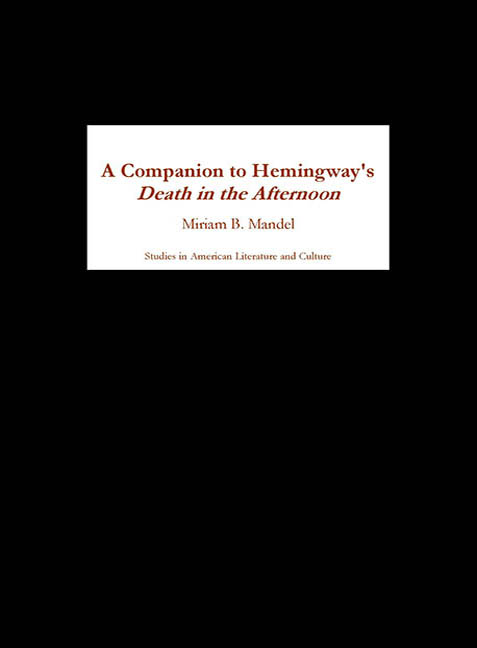Book contents
- Frontmatter
- Dedication
- Contents
- Acknowledgments
- Hemingway Works That Address the Bullfight
- A Note on the Text of Death in the Afternoon
- Introduction
- Composition, Sources, and Backgrounds
- Reading Texts, Paratexts, and Absence
- “The Real Thing–? Representing the Bullfight and Spain in Death in the Afternoon
- “Very Sad but Very Fine”: Death in the Afternoon 's Imagist Interpretation of the Bullfight-Text
- “Far from Simple”: The Published Photographs in Death in the Afternoon
- Deleted “Flashes”: The Unpublished Photographs of Death in the Afternoon
- “¿Qué tal, hombre, qué tal?”: How Paratexts Narrow the Gap between Reader and Text in Death in the Afternoon
- On Authorship and Art
- And What Came After
- Works Cited
- Notes on the Contributors
- Index
“¿Qué tal, hombre, qué tal?”: How Paratexts Narrow the Gap between Reader and Text in Death in the Afternoon
from Reading Texts, Paratexts, and Absence
Published online by Cambridge University Press: 27 April 2017
- Frontmatter
- Dedication
- Contents
- Acknowledgments
- Hemingway Works That Address the Bullfight
- A Note on the Text of Death in the Afternoon
- Introduction
- Composition, Sources, and Backgrounds
- Reading Texts, Paratexts, and Absence
- “The Real Thing–? Representing the Bullfight and Spain in Death in the Afternoon
- “Very Sad but Very Fine”: Death in the Afternoon 's Imagist Interpretation of the Bullfight-Text
- “Far from Simple”: The Published Photographs in Death in the Afternoon
- Deleted “Flashes”: The Unpublished Photographs of Death in the Afternoon
- “¿Qué tal, hombre, qué tal?”: How Paratexts Narrow the Gap between Reader and Text in Death in the Afternoon
- On Authorship and Art
- And What Came After
- Works Cited
- Notes on the Contributors
- Index
Summary
Gerard genette developed the concept of paratexts in his book, Seuils (1987; translated as Paratexts: Thresholds of Interpretation, 1997). As Genette defines the term, paratexts are any and all texts, inside and outside the covers of the book, that present, explain, situate, contextualize, illustrate, comment on, and classify the work for the reader. Genette distinguishes between two types of paratexts. Epitexts include any texts that are relevant to but not materially attached to the book: interviews, letters, diaries, and manuscripts containing authorial comment on the text. Peritexts, on the other hand, are those texts that are physically connected to the book (5). Genette maintains this distinction when discussing the relation between epitexts and peritexts — for example, when discussing what an author might say in his dedication (peritext) and in an interview (epitext). But in discussing the function of these texts and their relationship to the main text, Genette (and this essay in his wake) prefer the broader term, paratext. Because he defines paratexts as author-authorized matter (“something is not a paratext unless the author or one of his associates accepts responsibility for it” [9]), discussions of paratexts generally adopt the date of a text's original edition as their point of reference (5).
For Genette, all paratexts are subordinate to the main text. They occupy a threshold area filled with clues — some verbal, some iconic, some material, and some factual — whose function is to present the book to its readers. In short, they are devices and conventions that contain messages about how the book is to be received. Within this zone, both what is there and what is not there carry meaning. Literally or figuratively, verbally or visually, straightforwardly or obliquely, the presence or absence of matter on the cover and on the front and back pages has been calculated, as Genette explains, to influence the reader and to ensure that the text is properly read (2).
What is it, this text we are reading? And how — in what context, in what spirit — are we to read it? Death in the Afternoon has been variously identified and read as a personal memoir, an anatomy, a bullfight manual, a travel book, a dissertation on life and letters, and so on. Unsure of the book's genre, the reader is unsure about what literary conventions apply.
- Type
- Chapter
- Information
- A Companion to Hemingway's Death in the Afternoon , pp. 205 - 234Publisher: Boydell & BrewerPrint publication year: 2004

